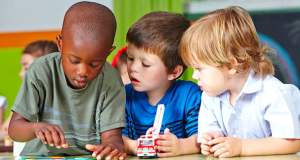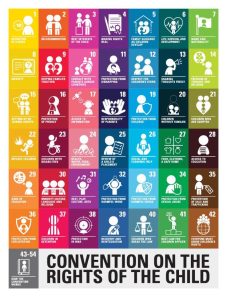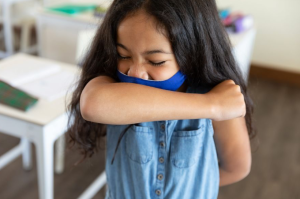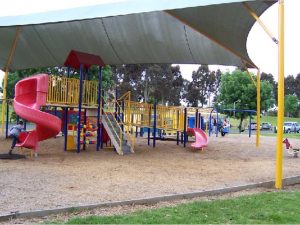Introduction
Learning Objectives
After completing this introduction to the book, you should be able to:
- Explain why health and well-being in early childhood is so important.
- Describe qualities and benefits of high-quality early care and education programs.
- Outline key topics related to health, safety and nutrition for young children.
- Discuss what licensing is and its role in keeping children safe and healthy.
A culture of wellness exists when the health and safety of staff and children are valued, supported, and promoted through health and wellness programs, policies, and environment.
Evidence shows that experiences in childhood are extremely important for a child’s healthy development and lifelong learning. How a child develops during this time affects future cognitive, social, emotional, language, and physical development, which in turn influences school readiness and later success in life.Research including a number of adult health and medical conditions, points to pre-disease pathways that have their beginnings in early and middle childhood.

During early childhood, the human brain grows to 90 percent of its adult size by age 3. Early childhood represents the period when young children reach developmental milestones that include:
- Emotional regulation and attachment
- Social development
- Language development
- Cognitive development
- Physical development (motor skills)
All these milestones can be significantly delayed when young children experience inadequate caregiving, environmental stressors, and other negative risk factors. These stressors and factors can affect the brain and may seriously compromise a child’s physical, social-emotional, and cognitive growth and development.
More than any other developmental periods, childhood sets the stage for:
- School success
- Health literacy
- Self-discipline
- The ability to make good decisions about risky situations
- Eating habits
- Conflict negotiation and healthy relationships with family and friends
Understanding Childhood Health Concerns
Although young children are typically healthy, it is during this time that they are at risk for conditions such as:
- Developmental and behavioural disorders
- Child maltreatment
- Asthma and other chronic conditions
- Obesity
- Dental caries (cavities)
- Unintentional injuries

While typically nonfatal, these conditions affect children, their education, their relationships with others, and the health and well-being of the adolescents and adults they will become.
Emerging Issues in Childhood Health
The keys to understanding childhood health are recognizing the important roles these periods play in adult health and well-being and focusing on conditions and illnesses that can seriously limit children’s abilities to learn, grow, play, and become healthy adults.
Prevention efforts in early and middle childhood can have lasting benefits. Emerging issues in early and middle childhood include implementing and evaluating multidisciplinary public health interventions that address social determinants of health by:
- Fostering knowledgeable and nurturing families, parents, and caregivers
- Creating supportive and safe environments in home, schools, and communities
- Increasing access to high-quality health care
Early Childhood Development and Education
Early childhood, particularly the first 5 years of life, impacts long–term social, cognitive, emotional, and physical development. Healthy development in early childhood helps prepare children for the educational experiences of kindergarten and beyond. Early childhood development and education opportunities are affected by various environmental and social factors, including:
- Early life stress
- Socioeconomic status
- Relationships with parents and caregivers
- Access to early education programs
Early life stress and adverse events can have a lasting impact on the mental and physical health of children. Specifically, early life stress can contribute to developmental delays and poor health outcomes in the future. Stressors such as physical abuse, family instability, unsafe neighborhoods, and poverty can cause children to have inadequate coping skills, difficulty regulating emotions, and reduced social functioning compared to other children their age.
Additionally, exposure to environmental hazards, such as lead in the home, can negatively affect a child’s health and cause cognitive developmental delays. Research shows that lead exposure disproportionately affects children from minority and low–income households and can adversely affect their readiness for school.
The socioeconomic status of young children’s families and communities also significantly affects their educational outcomes. Specifically, poverty has been shown to negatively influence the academic achievement of young children. Research shows that, in their later years, children from disadvantaged backgrounds are more likely to need special education, repeat grades, and drop out of high school. Children from communities with higher socioeconomic status and more resources experience safer and more supportive environments and better early education programs.
The Effects of Poverty on Education
“Canada’s overall poverty rate was estimated at 7.4% in 2021, up from 6.4% in 2020 and down from 14.5% in 2015. The poverty rate for children was 6.4% in 2021, up from 4.7% in 2020. When compared to 2015, there were approximately 653,000 fewer children living in poverty in 2021.” (Government of Canada, 2023)
“Poverty has a particularly adverse effect on the academic outcomes of children, especially during early childhood.” (American Psychological Association, 2020). Research has shown that children from families in poverty enter school with a readiness gap. Contributions to this gap include:
- Poor physical development and health (due to poor nutrition and lack of access to medical care)
- Challenges with concentration, memory, attentiveness, curiosity, and motivation9 due to the chronic stress of living in poverty
- Greater risk for behavioral and emotional problems
- Exposure to environmental hazards (such as lead paint) and violence in their communities
Two additional things that are important to note:
- Indigenous child poverty rates are much higher than the average child poverty rate in Canada. Indigenous children suffer a poverty rate of 40%compared to 15% for all other children in the country (Canadian Centre for Policy Alternatives, 2013).
- Families experiencing poverty have challenges finding affordable, high-quality early learning programs.
The National Association for the Education for Young Children (NAEYC)s says that high quality programs:
- Create caring communities of learners in which children develop relationships with each and the educators and each child and family are included.
- Teach to support children’s development and learning by being intentional with the environmental design, materials, and activities and by providing positive guidance for children’s behaviour.
- Have developmentally appropriate curriculum that helps children learn and grow that sets challenging, yet achievable goals for children, balances adult instruction and group activities with play and child-chosen experiences, provides enough time for deep engagement, and is based on the children’s interests, abilities, and knowledge.
- Regularly assesses children’s development and learning to inform their environmental design, curriculum, and interactions with children and their families.
- Is founded on partnerships with families in which families are respected and valued, share their goals and concerns, are encouraged to participate, and with clear communication (in a family’s home language whenever possible) (NAEYC, 2020).
High quality early learning programs support children, families, and communities by improving social, health and academic outcomes.
The benefits for children include:
- Improved physical and mental well-being
- Decrease in chronic health problems
- Increased self-confidence
- Improved outcomes in literacy, math, and science
- Higher rates of completing high school
- Increase in conflict resolution skills (Region of Waterloo Community Services, 2023)
The benefits for families and communities include:
- Increased number of women in the workforce
- Decreased need for social assistance
- Increased household income
- Decreased participation in criminal activity (Region of Waterloo Community Services, 2023)
To learn more about Ontario’s vision for the early years, go to How Does Learning Happen?
Early childhood development and education are key determinants of future health and well–being. Addressing the disparities in access to early childhood development and education opportunities can greatly bolster young children’s future health outcomes.
Additional research is needed to increase the evidence base for what can successfully impact the effects of childhood development and education on health outcomes and disparities. This additional evidence will facilitate public health efforts to address early childhood development and education as social determinants of health.
Importance of Considering Holistic Development
As educators we often find we are rushing through our day to ensure all routine tasks are complete. How can we slow down our day to consider wellness for children, their families, ourselves, our colleagues, and the communities we share with others? This book will explore ideas for embedding holistic health and wellness into our everyday practice in early childhood education and care.
It is important to remember the rights of the child. Health, safety, and nutrition are only some of the key aspects for consideration when respecting the rights of the child and finding ways to ensure holistic health and well-being are embedded in our daily practice with all who share the learning space and lands where we reside.

Focus on Wellness
Rather than waiting for health issues to arise, families and early childhood education programs should focus on supporting children’s wellness. “Wellness describes the entirety of one’s physical, emotional, and social health; this includes all aspects of functioning in the world (physiological, intellectual, social, and spiritual), as well as subjective feelings of well-being. A child who is doing well frequently experiences joy, delight, and wonder, is secure and safe in his/her family and community and is continually expanding and deepening his/her engagement with the world around him/her.” (Murphey, 2014)

Wellness is an active process. It requires awareness and direct, thoughtful attention to the choices we make. Early care and education programs can play a critical role in helping children, families and staff commit to and implement healthy lifestyle choices that promote both physical and mental well-being. The two, in fact, are closely linked. Our feelings, thoughts, and behaviours directly impact our physical health. Similarly, our physical health status has a direct impact on our feelings, thoughts, and behaviours.
We must also support children’s mental well-being and help them navigate everyday stress and adversity as well as trauma and significant sources of stress. The American Psychological Association shares that “building resilience — the ability to adapt well to adversity, trauma, tragedy, threats or even significant sources of stress — can help our children manage stress and feelings of anxiety and uncertainty.” (American Psychological Association, n.d.)
It is important that children are in an environment that keeps them physically and emotionally safe and healthy and provides sound nutrition. As an early educator, providing these requires attention, planning, and intention.
Engaging Families
Educators can use the following strategies to help families to develop their children’s health habits:
- Provide families with concise, accurate information about ways to promote and develop good health habits in children; information should be presented in English and the families’ home languages. Capture their interest by addressing topics related to their children’s age and development, as well as topics related to common health risks for children, such as childhood obesity, asthma, and dental caries. Injury prevention and first-aid topics, such as treating burns, bleeding, and choking, are also relevant. Provide written informational materials that are brief and easy to read.
- Provide individualized information, as well as general health information, to all families through daily contact, workshops, and parent meetings. All information should be presented in English and in the families’ home languages. Accommodate family schedules by providing workshops and meetings at various times (e.g., morning, afternoon, evening), and arrange for child care during meetings.
- Show family members what the children are learning by sending home examples of work, encouraging families to visit the preschool and observe children in action, and sharing children’s portfolios during home visits. Reinforce children’s learning about health habits through take-home activities, lending libraries of read-aloud books in the languages of the families in the group and displays of children’s work.
- As you introduce health routines (e.g. handwashing, tooth brushing), invite family members to participate and model. Encourage families to contribute ideas or materials to interest areas that reflect diverse health habits at home.
- Identify community resources related to health habits (e.g., handwashing, tooth brushing) and invite community personnel to participate in and bring resources to family workshops or parent meetings. Emphasize the role of home and family members in helping children to develop health habits and inform all parents of the availability of free and low-cost community resources.
- Be sensitive to and respectful of different values or beliefs, as well as varying levels of access to health products and services. Gather information on available and accessible resources in the community, including those for children with special needs, and provide this information to all families, translated into their home languages.
Introduction to Health, Safety and Nutrition in Canadian Early Learning Environments
This book is divided into eight Units:
Unit 1: Promoting Health and Wellness
Unit 2: Health and Wellness for Educators
Unit 3: Illness Prevention
Unit 4: Illness Management
Unit 5: Nutrition
Unit 6: Promoting Healthy Active Living
Unit 7: Safety
Unit 8 : Preventing Child Maltreatment
Units 1, 2 3 and 4: Health
“Health is more than merely the absence of disease—it is an evolving human resource that helps children and adults adapt to the challenges of everyday life, resist infections, cope with adversity, feel a sense of personal well-being, and interact with their surroundings in ways that promote successful development.” (National Forum on Early Childhood Policy and Programs & National Scientific Council on the Developing Child, n.d.)

Research is showing that many adult health issues, such as high blood pressure, heart disease, and diabetes, are linked to what happens during early childhood (and even prenatally!). We also know that during early childhood there are biological systems that are more sensitive to environmental factors (such as child maltreatment, malnutrition, and recurring issues to infectious disease).
It is vital for children and their families to have support for children’s physical, oral, and mental health. This happens through promoting health and protection from illness.
Unit 1 looks at promoting health and wellness, supportive health care, children with special healthcare needs and children’s mental health.
Unit 2 focuses on health and safety issues for early childhood educators.
Unit 3 covers how illness are transmitted, immunizations, universal precautions, and environment health issues.
Unit 4 explores illness management, including daily observation of children, documenting health observations and administering medication.
Units 5 and 6: Nutrition
Healthy eating and being active are essential to a child’s well-being. Children who are under- or over-nourished are at risk for chronic health problems. Early childhood is an important time for developing healthy habits for life. Children’s bodies grow and develop in ways that affect the way they think, eat, and behave.
A healthy diet not only affects growth, but also immunity, intellectual capabilities, and emotional well-being. Families and educators must ensure that children receive an adequate amount of needed nutrients to provide a strong foundation for the rest of their lives.

Unit 5 addresses basic nutrition for children, protecting good nutrition and physical wellness, providing good nutrition, menu planning and food safety.
Unit 6 looks at promoting healthy active living by exploring strategies for increasing physical activity and decreasing screen time.
Units 7 and 8: Safety
Children are curious and eager to learn. They depend on their caregivers to keep them safe by making sure that nothing within a child’s reach can harm them. Injuries are a serious health risk to young children. But most injuries are predictable and preventable.

Early learning and childcare programs can prevent risks and unnecessary harm to children by committing to a culture of safety. A culture of safety prioritizes safety at all levels. It encourages programs to learn from past problems and prevent them in the future. Programs should not assume that nothing will ever go wrong. In fact, they should plan that something is going to go wrong. And their goal is to make it as hard as possible for things to go wrong.
Unit 7 focuses on preventing injuries by creating safe indoor and outdoor learning environments, treating minor injuries, and preparing for/managing emergencies.
Unit 8 discusses types of child maltreatment and strategies for preventing child maltreatment.
Health, Safety and Nutrition and the Ontario Child Care and Early Years Act (2014)
In Ontario, child care providers are governed by the requirements set out in the Child Care and Early Years Act, 2014 (CCEYA) and O.Reg.137/15: GENERAL. Licensing of child care providers is overseen by the Ministry of Education.
The CCEYA and O.Reg.137/15: GENERAL applies to:
- unlicensed child care providers
- licensed child care centres
- licensed home child care agencies
- home child care providers that are overseen by a licensed agency
- providers of in-home services that are overseen by a licensed agency
Section 1(1) of the CCEYA states “The purposes of this Act are to foster the learning, development, health and well-being of children and to enhance their safety.” (Child Care and Early Years Act, 2014)
In O.Reg.137/15: GENERAL, made under the Child Care and Early Years Act (2014):
- Health and Medical Supervision regulations are found in Sections 32-41.
- Nutrition regulations are found in Sections 42-44.
- Safety is the underlying goal of many of the sections, including staff-to-child ratios and maximum group sizes, building, equipment and playground regulations, prohibited behavior management practices, staff qualifications, staff screening measures and vulnerable sector checks and emergency preparedness. In addition to these regulations, child care services must also be in compliance with other laws, regulations and codes including but not limited to the Safe Drinking Water Act, the Smoke-Free Ontario Act, the Ontario Fire Code and the Ontario Building Code.
Pause to Reflect 💭
As you progress through this book, what connections can you make about how being knowledgeable about health, safety, and nutrition will support early childhood educators in both following licensing and other applicable regulations and ensuring they provide high quality care for young children and their families?
Important Things to Remember
Although the book is divided into Units, they are interconnected. This is a foundational book that will support knowledge in many courses in Early Childhood Education programs. It can also be used as a reference when employed in early learning environments.
References
American Psychological Association. (2020). Effects of Poverty, Hunger and Homelessness on Children and Youth .https://www.apa.org/topics/socioeconomic-status/poverty-hunger-homelessness-children
American Psychological Association. (n.d.). Resilience Guide for Parents and Teachers. https://www.apa.org/helpcenter/resilience.
Canadian Centre for Policy Alternatives (2013). Poverty or Prosperity: Indigenous Children in Canada. https://policyalternatives.ca/sites/default/files/uploads/publications/National%20Office/2013/06/Poverty_or_Prosperity_Indigenous_Children.pdf
Child Care and Early Years Act, 2014. https://www.ontario.ca/laws/statute/14c11
Government of Canada (2023). Canada’s poverty rate remains below pre-pandemic levels. https://www.canada.ca/en/employment-social-development/news/2023/05/canadas-poverty-rate-remains-below-pre-pandemic-levels.html
Murphey, D., et al. (2014). Are the Children Well? A Model and Recommendations for Promoting the Mental Wellness of the Nation’s Young People. Robert Wood Johnson Foundation. https://www.childtrends.org/wp-content/uploads/2014/07/2014-33AreChildrenWellRWJF.pdf
NAEYC. (2020). What Does a High-Quality Preschool Program Look Like? https://www.naeyc.org/our-work/families/what-does-high-quality-program-for-preschool-look-like
National Forum on Early Childhood Policy and Programs & National Scientific Council on the Developing Child. (n.d.). The Foundations of Lifelong Health are Built in Early Childhood. https://46y5eh11fhgw3ve3ytpwxt9r-wpengine.netdna-ssl.com/wp-content/uploads/2010/05/Foundations-of-Lifelong-Health.pdf
Region of Waterloo Community Services (2023). High Quality Licensed Child Care Fact Sheet. https://www.regionofwaterloo.ca/en/living-here/resources/Childrens-Services/Region_of_Waterloo_Child_Care_Fact-Sheet-accessible.pdf

